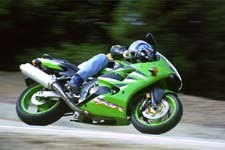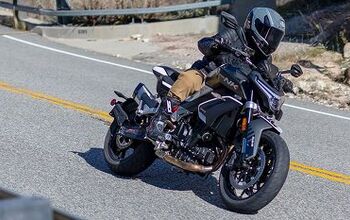
Torrance, California, June 1, 2001
It comes as no surprise that the manufacturers put so much effort into the 600-class machines they produce.
Most Open Class bikes today produce over 130-horsepower, offer razor-sharp handling that Superbikes of only a few years ago struggled to attain, and are on the abosulte edge of insanity. But what makes the 600s such a sticking point for the manufacturers is that these bikes are as close as you'll likely ever come to getting your hands on anything your favorite rider will race. The old adage, "Win on Sunday, sell on Monday" still holds true today as these are the manufacturers' best-selling sportbikes year after year.
When manufacturers plan their next models, they look to the racetrack as their target -- though some obviously look harder than others. Yamaha has obviously spent some serious time in the lab, the dyno room and on the track, the fruits of their labor being MO's Year 2001 World Supersport Shootout winning YZF-R6. Of the bikes that could possibly be included in that shootout, a few were MIA for reasons we didn't have control over. But we have them here now, as Triumph's TT600 and Kawasaki's ZX-6R get set to take on the current track terror Yamaha. It's a perfect set-up, actually, with last year's winner facing off against this year's winner with the new guy thrown into the fray just because you readers seem to want it this way. So it's a three way battle with an emphasis on street riding just like you requested in various polls. Off we go, then...
Yamaha YZF-R6
Yamaha's R6 barely missed out on a win in the Year 2000 World Supersport shootout because, although its track manners were top shelf, some felt it had a few too many shortcomings on the street. But times change and the big, little Yamaha got a few touch-ups that added more power and sharpened an already slick package for the 2001 model year. These changes were enough that the overall shootout balance was swayed in the R6's favor as it's superb motor and balance helped it to eek out a win over the all-around Honda CBR600F4i.
"Since its debut in 1999, only a year after its big brother R1 debuted, the R6 has been a staff favorite."
It's routinely called the closest thing to a 250 Grand Prix bike a "normal" person can buy, though therein lies its faults according to some. You see, the Yamaha, just like the dedicated Suzuki GSX-R600, makes no contentions about it's true direction in life. Both bikes are meant for all-out track warfare, though the Suzuki is the hardest-edged, leaving the Yamaha feeling almost cushy in comparison. But in the company of this particular bunch, it's the brawler in your
kid's pre-school class.
In comparison to the other bikes here, the Yamaha is a racebike with a license plate. Its motor has most of its power situated in the upper portion of the rev range and will walk away from the other bikes if you let the motor run free. In the low-to-mid portion though, the R6's mill gets trounced by the Kawi. The Yamaha's handling, however, was by far the most precise whether the speeds were legal or hand-me-your-license-now illegal. The blue and white bike simply reads your mind and responds, sometimes before you can even finish a thought. It's transmission is a weak spot, however. It was occasionally viewed as notchy in our World Supersport Shootout, and in this company it falls somewhere in the middle, behind the Kawi though well ahead of the Triumph.
The only other real gripe we can fathom about the Yamaha is it's throttle response which can be, at times, jerky. This is most likely due to lean carburetion in order to slide under various EPA guidelines -- part of the same issue that also causes the bike to occasionally pop on deceleration. As nagging little things like this go in an otherwise stellar package, things get overlooked if there are enough other good things to focus on. Thankfully for Yamaha, there are plenty of good things to focus on here.
Kawasaki ZX-6R
The Kawasaki has made us a happy lot since the first time we threw a leg over it. In the group of repli-racers it's usually included in, it's the nice guy of the bunch, giving up some track dedication in favor of a more relaxed and friendly personality. The Kawasaki won our Year 2000 World Supersport Shootout by virtue of this, since it is as comfortable after umpteen hours droning along the highway as it is dragging pegs and other parts at the racetrack.
The Kawasaki has the best motor for streetwork, pulling strong from as little as 5,000 RPM into a surging mid-range and into a top-end that's very respectable if not downright impressive. Between the cases you'll also find the slickest shifting transmission of the bunch. The clutch works pretty well, too.
Ergonomically, the rider is situated in a position that's neither committed to sport nor touring duty. It strikes a nice balance that -- at least in this group -- has your mind thinking this machine is an inline-four version of Honda's excellent VFR800.
On a twisty back road, the Kawi changes direction well, though it takes a bit more muscle than either of the other bikes if you really want to hustle. This trait, however, is part of what helps to make the bike so stable over irregular pavement or slashing around at high speed. It's these same situations that have Yamaha pilots making mental notes to make their next purchase a steering damper and the Triumph people wishing they had the motor to find out what their bike might behave like at these speeds.
Other bests in this group are the Kawasaki's brakes which have excellent initial bite and will get the bike hauled down from speed with little more effort than it takes to open a screen door.
In this three bike group, the Kawasaki feels like a hero until the pace elevates and the front end starts to push and the bike starts to wallow a bit. The ZX-6R, just like the ZX-9R, is a big, hefty bike. This isn't a bad thing, mind you, just something you're always aware of. On the open road, the excellent wind protection and supple suspension are what you get in trade for this bit of heft in the tighter twisty bits, though most view this as a welcome trade for real-world riding. The Kawasaki has even been called a "sport-tourer" by one large print publication. All this comfort and it can scratch with the best of 'em, too.
Triumph TT600
If the Gods must be crazy, then surely the Triumph boys aren't far behind your favorite deity. The boys from Hinckley couldn't have picked a more competitive class to enter into with a design that puts them on a level playing field with everybody else. Ditching their get-out-of-jail-free card of an in-line triple leaves behind the excuse of the motor's "character" making up for the rest of the bike's lack of performance. But what if the bike's performance isn't that far behind everybody else? After sampling the new TT600 a few weeks ago, we are still quite impressed by how good Triumph's first-year effort is. This isn't to say that the bike doesn't have its share of quirks, but we certainly expected more teething problems.
"The best feature about the TT600 is its chassis."
The aluminum beam perimeter frame and well-damped suspension work in concert with each other, providing enough feedback and rigidity without becoming harsh at any time. In comparison, the Yamaha's suspension is stiff and very track-oriented while the Kawasaki's set-up feels a bit vague when pushed. The level of refinement in the Triumph's chassis seems to strike a near-perfect real-world balance between control and compliance. A very impressive first year effort, indeed. The motor, however, is not so impressive. Though it revs out and feels like it makes decent horsepower up top, when you're running with the other bikes in this group, you tend to get left behind. The Kawasaki has more motor everywhere, and the Yamaha walks away once things really start spinning, leaving the Triumph rider to rely on a chassis to compensate for a large horsepower deficit.
Setting the TT600 further back in this group is the shifting (worst here) and that nuisance of a fuel-injection glitch that's present every time you twist the throttle in on/off transitions. Help from a Keihin part or three on next year's model is supposed to clear this up, though we're left with Sagem stuff for the moment.
Wind protection is decent and the reach to the bars is very similar to that of the Honda F4i, being just better than the R6 for street duty yet quite a bit behind the Kawasaki's bubble of pleasure. The seat-to-peg relationship, however, is mis-matched and feels more like a GSX-R600 than it probably should. It's still a very good bike, though. It's something for the person who doesn't want to join the Ricky Racer clone crowd, yet still wants a 600 class sportbike that can do it all.
Something of a Summary
So what have we learned here? The same old story, really, as (say it with us now) "any of these bikes would make it's owner the happiest person alive." We are a wretched lot, aren't we? You see, that statement isn't as mamby-pamby as you might otherwise think. Each bike here is very good.
For example, one of the test riders we had along with us for some photos (he works at a rather significant weekly print book) commented how, when he was on any of these particular bikes alone, he thought it was the absolute best in class. Only when compared back-to-back on the same roads did each bike's character flaws surface. After a few post-ride adult beverages, we were all nodding in agreement at this most astute theory.
Both Japanese-built machines are quite a bit ahead of the Triumph in outright performance, and leave the first-year effort looking as such, in need of further development. It's a good bike, mind you, but it just pales in comparison to the more refined and well-developed offerings from the land of the rising sun. And of the remaining two machines, it seems that whenever a staff member or test rider was leaving for a long day's ride, his mount of choice was always the Kawasaki. It's comfortable (have we said this enough already?) and capable. It gets the job done, whatever that job is, and only fails to continually impress when in the company of other bikes who might just have one or two little things they do better than the green bike.
If you want a good bike that's different, then the Triumph is a solid choice any owner would be happy with. And if track days are an important part of your future plans, then the Yamaha is a good streetbike with a forte' for just that sort of thing. As an overall package, though, it's surely hard to fault the Kawasaki for all-around street goodness.

Motorcycle.com presents an unrivaled combination of bike reviews and news written by industry experts
More by Motorcycle.com Staff





































Comments
Join the conversation